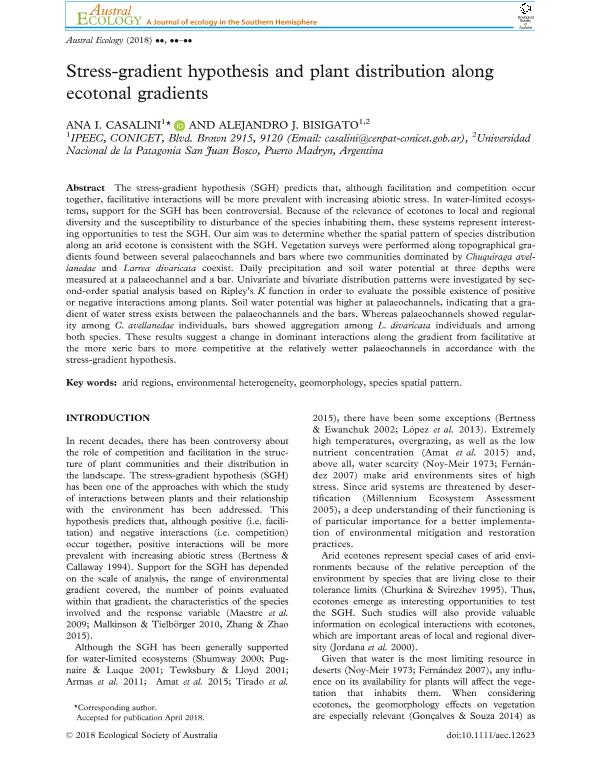Artículo
Stress-gradient hypothesis and plant distribution along ecotonal gradients
Fecha de publicación:
11/2018
Editorial:
Wiley Blackwell Publishing, Inc
Revista:
Austral Ecology
ISSN:
1442-9985
Idioma:
Inglés
Tipo de recurso:
Artículo publicado
Clasificación temática:
Resumen
The stress-gradient hypothesis (SGH) predicts that, although facilitation and competition occur together, facilitative interactions will be more prevalent with increasing abiotic stress. In water-limited ecosystems, support for the SGH has been controversial. Because of the relevance of ecotones to local and regional diversity and the susceptibility to disturbance of the species inhabiting them, these systems represent interesting opportunities to test the SGH. Our aim was to determine whether the spatial pattern of species distribution along an arid ecotone is consistent with the SGH. Vegetation surveys were performed along topographical gradients found between several palaeochannels and bars where two communities dominated by Chuquiraga avellanedae and Larrea divaricata coexist. Daily precipitation and soil water potential at three depths were measured at a palaeochannel and a bar. Univariate and bivariate distribution patterns were investigated by second-order spatial analysis based on Ripley's K function in order to evaluate the possible existence of positive or negative interactions among plants. Soil water potential was higher at palaeochannels, indicating that a gradient of water stress exists between the palaeochannels and the bars. Whereas palaeochannels showed regularity among C. avellanedae individuals, bars showed aggregation among L. divaricata individuals and among both species. These results suggest a change in dominant interactions along the gradient from facilitative at the more xeric bars to more competitive at the relatively wetter palaeochannels in accordance with the stress-gradient hypothesis.
Archivos asociados
Licencia
Identificadores
Colecciones
Articulos(IPEEC)
Articulos de INSTITUTO PATAGONICO PARA EL ESTUDIO DE LOS ECOSISTEMAS CONTINENTALES
Articulos de INSTITUTO PATAGONICO PARA EL ESTUDIO DE LOS ECOSISTEMAS CONTINENTALES
Citación
Casalini, Ana Isabel; Bisigato, Alejandro Jorge; Stress-gradient hypothesis and plant distribution along ecotonal gradients; Wiley Blackwell Publishing, Inc; Austral Ecology; 43; 7; 11-2018; 807-816
Compartir
Altmétricas




